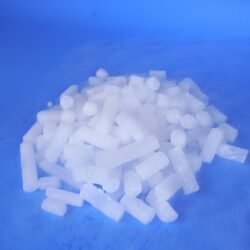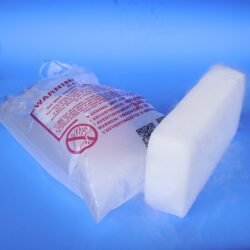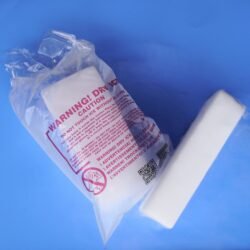Keeping insects away from stored food, enclosed spaces, and sensitive materials can be a challenge. Chemical sprays often come with harmful side effects, making it essential to explore safer alternatives. Dry ice for protection against insects is an effective, chemical-free solution that uses the power of carbon dioxide to create an inhospitable environment for pests.
As dry ice sublimates, it releases carbon dioxide, which displaces oxygen in the surrounding area. This creates an environment where insects cannot survive, making dry ice an ideal choice for protecting stored goods, enclosed containers, and sensitive materials.
Why Dry Ice is Effective for Insect Protection
1. Displaces Oxygen and Suffocates Pests
Dry ice sublimates into carbon dioxide gas, which is heavier than oxygen. When placed in an enclosed space, it replaces the oxygen, creating an environment where insects cannot survive. This method is highly effective for eliminating pests without using harmful chemicals.
2. Safe for Food and Sensitive Materials
Unlike chemical sprays that can contaminate food or damage sensitive materials, dry ice for protection against insects is completely safe. It leaves no residue and poses no risk of contamination, making it an ideal solution for preserving stored goods.
3. Works in Sealed Containers and Enclosed Spaces
Dry ice is particularly effective when used in sealed containers or enclosed storage spaces. As the carbon dioxide fills the space, it eliminates insects that may be hiding inside, ensuring that the contents remain pest-free.
How to Use Dry Ice for Protection Against Insects
To maximize the effectiveness of dry ice in insect control, follow these simple steps:
1. Choose the Right Container
Use an airtight container or sealed space where the carbon dioxide can displace oxygen effectively. This could include food storage containers, storage bins, or enclosed packing areas.
2. Add the Right Amount of Dry Ice
Place a small amount of dry ice at the bottom of the container. Dry ice pellets work best for this purpose, as they sublimate quickly and fill the space with carbon dioxide.
3. Seal the Container and Allow Time for Sublimation
Seal the container to prevent the carbon dioxide from escaping. Allow the dry ice to fully sublimate, which typically takes a few hours. During this time, the oxygen will be displaced, creating an environment where insects cannot survive.
Choosing Between Dry Ice Blocks and Pellets for Insect Protection
When it comes to selecting the right dry ice product for insect control, understanding the difference between dry ice pellets and dry ice blocks is essential.
1. Dry Ice Pellets for Quick and Even Distribution
Dry ice pellets are small, cylindrical pieces of dry ice that sublimate quickly, releasing carbon dioxide at a faster rate. These pellets are ideal for situations where:
- You need rapid insect elimination in a short time.
- The container or enclosed space is small and requires even distribution of carbon dioxide.
- Quick results are required for food storage or sensitive material preservation.
Because of their size, pellets fill the space quickly, making them perfect for eliminating insects in tight or confined areas.
2. Dry Ice Blocks for Longer-Lasting Protection
Dry ice blocks sublimate at a slower rate, providing a more extended release of carbon dioxide. They work best when:
- You need prolonged protection against insects over an extended period.
- The enclosed space is larger, and a steady release of carbon dioxide is required.
- You’re looking to maintain a pest-free environment for longer durations without the need for frequent reapplication.
For long-term pest protection, using dry ice blocks ensures a consistent release of carbon dioxide, keeping insects at bay for extended periods.
Other Common Uses for Dry Ice
Dry ice has many practical applications across various industries. It is widely used for cooling, preservation, and creating visual effects. Some of the most common dry ice uses include:
- Dry ice for food storage keeps perishable items fresh by maintaining ultra-low temperatures during storage and transport.
- Dry ice for medical research and laboratory uses ensures that biological samples and sensitive materials remain stable at controlled temperatures.
- Dry ice for biomedical product storage protects temperature-sensitive biomedical products during transport by maintaining the required cold chain.
- Dry ice for hunting and fishing storage preserves game and fish, preventing spoilage and maintaining freshness during transport.
- Dry ice for cancer patient cold cap therapy storage maintains cold caps at the necessary temperatures to reduce hair loss during chemotherapy.
- Dry ice for making seltzer and other carbonated beverages carbonates drinks by releasing carbon dioxide during sublimation.
- Dry ice for making fog creates dense, low-lying fog effects that enhance visual experiences at events and performances.
Safety Guidelines for Using Dry Ice for Insect Control
Dry ice is effective but requires careful handling to ensure safety.
- Use Insulated Gloves: Handle dry ice with insulated gloves to prevent frostbite.
- Allow Ventilation in Containers: While sealing is necessary for pest control, ensure that containers are properly vented to prevent pressure buildup.
- Avoid Direct Contact with Skin: Never handle dry ice with bare hands, as direct contact can cause burns or frostbite.
Final Thoughts: Why Dry Ice is the Best Solution for Insect Protection
Dry ice for protection against insects is a safe, chemical-free, and highly effective method for eliminating pests from enclosed spaces. By displacing oxygen with carbon dioxide, dry ice creates an inhospitable environment where insects cannot survive.
For added security, using a silver mylar bag provides an extra layer of protection, preventing insects from accessing stored goods. Whether protecting food, sensitive materials, or enclosed containers, dry ice offers a natural, reliable, and safe solution for pest control.




